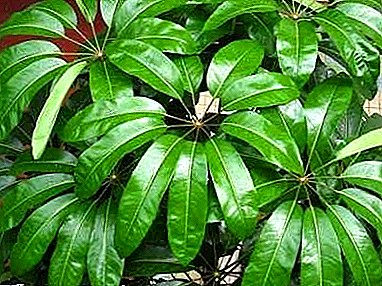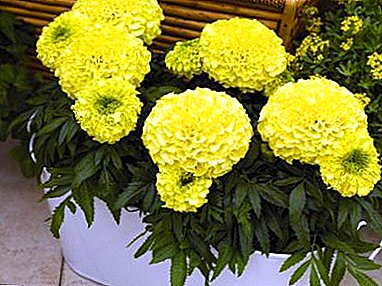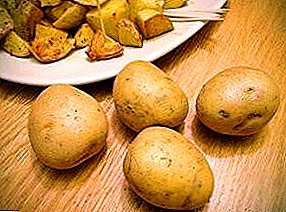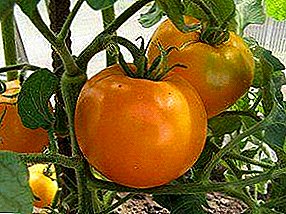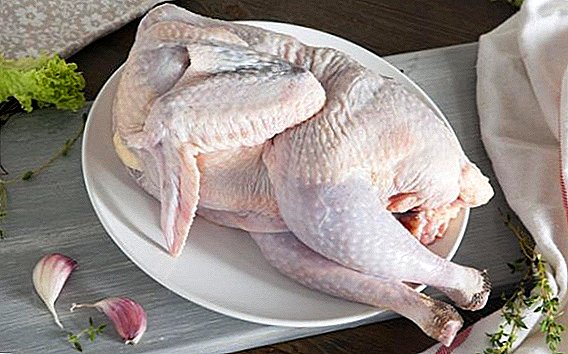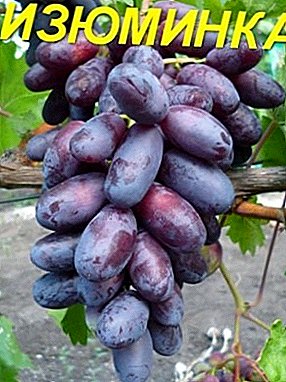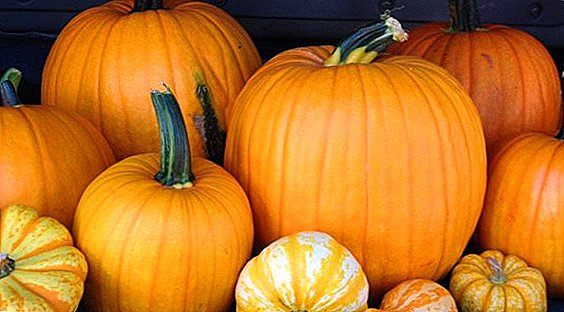 Pumpkin is a unique product, indispensable for baby and dietary food, a storehouse of nutrients, vitamins and microelements. In our latitudes, three types of pumpkin are mainly cultivated: the hard-faced, nutmeg and large-fruited. They vary depending on the taste of the pulp, the size of the fruit and the softness of the skin.
Pumpkin is a unique product, indispensable for baby and dietary food, a storehouse of nutrients, vitamins and microelements. In our latitudes, three types of pumpkin are mainly cultivated: the hard-faced, nutmeg and large-fruited. They vary depending on the taste of the pulp, the size of the fruit and the softness of the skin.
Pumpkin large-fruited has a large variety of varieties, which will be discussed in this article.
Features of large-fruited pumpkin varieties
As you might guess from the name, the large-fruited pumpkin is characterized by large fruit sizes, the weight of the standard ones varies between 20-50 kg, and sometimes it can even reach 100 kg. But it is also the sweetest kind of pumpkin, the sugar content of some varieties reaches 15%, which is even more than in watermelon. However, this is the most unpretentious and cold-resistant pumpkin variety, which has a high yield. Its thick, fleshy rind promotes long-term storage of the fetus and good transportability.  Large pumpkin varieties have round, cylindrical stems and a rounded stem, without furrows. Leaves are pentagonal and reniform. The seeds are large, dull, milky-white or brown.
Large pumpkin varieties have round, cylindrical stems and a rounded stem, without furrows. Leaves are pentagonal and reniform. The seeds are large, dull, milky-white or brown.
Important! Pumpkin pulp of large-fruited varieties has been successfully used in cooking and as a nutritious food for animals. It includes a large number of nutrients: vitamins A, C, E, K, PP, vitamins of group B, as well as potassium, calcium, magnesium, phosphorus, iron, copper, amino acids, etc.The fruits of large pumpkin have medicinal properties and are used in cases of high acidity and stomach diseases, even ulcers. Raw pumpkin pulp has a laxative effect, and pumpkin juice is an excellent diuretic and choleretic agent. Central and South America is considered the birthplace of this pumpkin, in Europe it appeared from the XYI century, and today it is cultivated all over the world.
Did you know? The inhabitants of ancient China considered the large pumpkin to be the queen of vegetables and grew it specially in the emperor's courtyard. As a sign of special mercy, the emperor gave the largest fruits to his best approximate.
The best large-fruited varieties
Large pumpkin is distinguished by a variety of varieties and species, of which there are about 100, and is a popular breeding product. Pumpkin fruits of different varieties vary in size and taste. In the middle and southern latitudes, the most successfully cultivated varieties are Smile, Curative, Azure and Crocus.
Smile
One of the representatives of the large pumpkin is the variety Smile. This pumpkin is distinguished by early ripening (85 days), increased cold resistance and gives a good harvest. The fruits of the Smile variety are round and very small, about 2-3 kg, covered with bright orange bark with white veins. The flesh is sweet, crunchy, bright orange in color, has a melon flavor.  The plant of this variety has a bush form, so it is convenient to grow it even in small areas. A smile also refers to a decorative variety of large pumpkin, it can be grown as a garland if planted near a trellis.
The plant of this variety has a bush form, so it is convenient to grow it even in small areas. A smile also refers to a decorative variety of large pumpkin, it can be grown as a garland if planted near a trellis.
Did you know? Recorded record weight ever grown large pumpkin is 250 kg. Raised her Wayne Hockney, a resident of the city of New Milford, USA.
Titanium
Mid-season climbing pumpkin that combines many qualities: good taste, large fruit, the possibility of long-term storage, attractive appearance. This variety is cultivated mainly because of its outstanding size, but its good taste makes Titan one of the best varieties of large-fruited pumpkin.  Pumpkin Titan has a yellow, thick, sweet enough flesh. The fruits are especially large, reaching 50-100 kg of weight. Prefers pumpkin fertile, light soil, light-requiring, does not tolerate waterlogging. Well responds to organic and mineral fertilizers. In order to grow such a giant, only one pumpkin is left on the scourge, so a small area for this variety will not be enough. In addition, pumpkins Titans love humus-rich soil.
Pumpkin Titan has a yellow, thick, sweet enough flesh. The fruits are especially large, reaching 50-100 kg of weight. Prefers pumpkin fertile, light soil, light-requiring, does not tolerate waterlogging. Well responds to organic and mineral fertilizers. In order to grow such a giant, only one pumpkin is left on the scourge, so a small area for this variety will not be enough. In addition, pumpkins Titans love humus-rich soil.
Parisian red
Pumpkin Parisian red is an interesting and unusual variety, bred in France. It differs in dark red color of the bark of the fruit and rather large in size: such a pumpkin can weigh up to 20 kg. The variety is table, medium late, ripens 101-118 days. The plant is strong, powerful, segmented fruits. The bark is thin and leathery. The color of the flesh of the Parisian red pumpkin is pale yellow. The pulp is thick, thick, fragrant, sweet.  It is characterized by good keeping quality and transportability. He likes sunny, warm places and the southern slope. Basically, the pumpkin of this variety is grown as animal feed, but due to its high taste, it is suitable for humans.
It is characterized by good keeping quality and transportability. He likes sunny, warm places and the southern slope. Basically, the pumpkin of this variety is grown as animal feed, but due to its high taste, it is suitable for humans.
Therapeutic
 Pumpkin Medical - an early ripe grade (95-100 days) of table purpose recommended for diet food. Short-pleated, with a shortened central whip. Fruits are round, flattened, slightly segmented, reaching a weight of 3-5 kg. The color of the bark is light gray, covered with a grid of a darker color. The peel is leathery, thin. The flesh is crispy, juicy, sweetish, orange. This grade is quite resistant to low temperatures up to -2 ° C. The medical pumpkin differs in high productivity, transportability and a keeping quality of fruits. It prefers sandy and light loamy soils (most often the pumpkin is planted on compost heaps).
Pumpkin Medical - an early ripe grade (95-100 days) of table purpose recommended for diet food. Short-pleated, with a shortened central whip. Fruits are round, flattened, slightly segmented, reaching a weight of 3-5 kg. The color of the bark is light gray, covered with a grid of a darker color. The peel is leathery, thin. The flesh is crispy, juicy, sweetish, orange. This grade is quite resistant to low temperatures up to -2 ° C. The medical pumpkin differs in high productivity, transportability and a keeping quality of fruits. It prefers sandy and light loamy soils (most often the pumpkin is planted on compost heaps).
Yellow centner
Mid-season grade (98-105 days) of German selection. Powerful, long-flowing pumpkin with very large fruits, reaching a weight of 60 kg or more. Fruits are flat, segmented, golden yellow. The flesh of the pumpkin is orange, sweet and thick. The variety is valued for its high content of carotene and sugar in the pulp and is used for the production of baby food. Due to the relatively large size of the fruit, sometimes reaching up to 100 kg, this variety is grown mainly for the sake of seeds.
Spray gold
 The bush golden gourd is a mid-ripening variety of large pumpkin, it grows for 98-105 days. The plant is short, bush or semi-bush. Fruits are round, slightly segmented, flattened. Their weight ranges from 3 to 5 kg, depending on the type of soil. This variety responds well to organic fertilizers.
The bush golden gourd is a mid-ripening variety of large pumpkin, it grows for 98-105 days. The plant is short, bush or semi-bush. Fruits are round, slightly segmented, flattened. Their weight ranges from 3 to 5 kg, depending on the type of soil. This variety responds well to organic fertilizers.
The color of the peel is golden orange and golden yellow with lighter veins. The crust is medium thick, leathery. The flesh is rich yellow, crunchy, moderately juicy and sweet, has excellent taste.
Crocus
Crocus is a short-ripening, mid-season (108-112 days), bush gourd. It has slightly segmented, rounded, spherical fruits. Color of a peel is gray-green, monophonic. Fruit weight reaches 5-8 kg, and in some cases reaches up to 20 kg. Crocus pulp is dense, thick, bright yellow, juicy, has good taste. The variety is cold-resistant, can tolerate a decrease in temperature to -1-2 ° C. The fruits have good keeping quality and transportability. This variety of large pumpkin is the easiest to grow, it has a high resistance to powdery mildew and bacteriosis - the main diseases affecting pumpkins. 
Merchant
Variety of table destination. Medium late (110-115 days), long-glistening plant. The average weight of the pumpkin variety Kupchikha - about 8-10 kg, and the maximum reaches 22-24 kg. Fruits are oblate, rounded, orange-yellow, have good transportability and keeping quality. The flesh is orange, dense, starchy, juicy, has a good taste. The fruit has large seeds, covered with a white, durable, rough skin. 
Azure
Medium late variety (99-123 days) with the fruits of the table purpose. The plant has a long, powerful lash. Pumpkin Azure has oblate, rounded fruits, dark green and dark brown, grayish in color, with a wrinkled, segmented surface. Fruits reach a mass of about 6 kg. The flesh is bright orange, thick, juicy, sweet, crunchy with excellent taste, ideal for diet food. The variety loves sandy and loamy soils, is characterized by unpretentiousness and resistance to low temperatures. Differs in high yield, good transportability and keeping fruit.
 With regard to agricultural engineering, all of the above varieties have similar bases and rules for planting. They love fertile, moisture-consuming, medium loamy, sandy-loamy soils and lighted, well warmed places, protected from cold gusts of wind. The dates of sowing of seeds of large-fruited pumpkin varieties for open ground and for seedlings - end of April - mid-May.
With regard to agricultural engineering, all of the above varieties have similar bases and rules for planting. They love fertile, moisture-consuming, medium loamy, sandy-loamy soils and lighted, well warmed places, protected from cold gusts of wind. The dates of sowing of seeds of large-fruited pumpkin varieties for open ground and for seedlings - end of April - mid-May.
Important! The root system of a large pumpkin is powerful, deep (from 1.7 to 4-5 m), therefore it cannot be planted in places of close groundwater occurrence.Large pumpkins love mineral and organic fertilizers. As a substrate for autumn digging make 4-6 kg of compost per square meter. Pumpkin is fed with fertilizers from superphosphate (25-30 g), potassium sulfate (15-20 g), and in the spring, urea (15-20 g).
Having studied the best large-fruited pumpkin varieties with a description of their advantages, you need to choose which variety to plant, based on the preferences and goals of cultivation: whether you want to harvest a large amount of seeds and store the crop for a long time or use it exclusively for culinary purposes, for children and diet. However, it is worth remembering that, the larger the fruit, the more difficult it is to achieve its maturation, excellent taste and high content of useful components.


